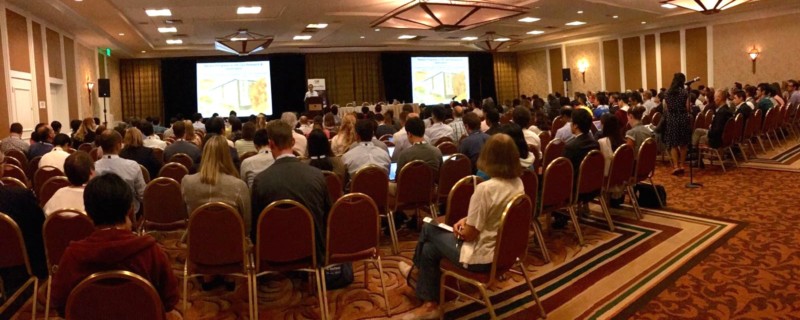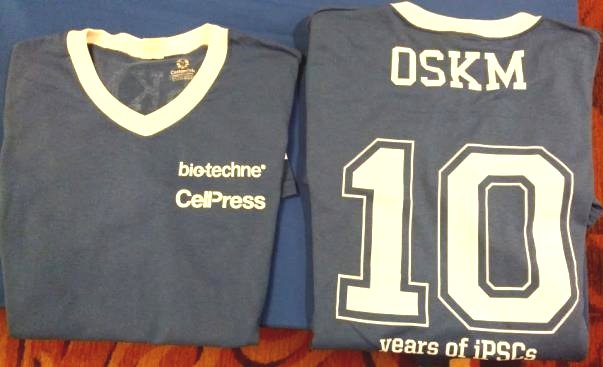
A Celebration of iPSCs – Highlights from the 10 Years of iPSCs Cell Symposia
A Guest Blog by Scott Schachtele, Product Manager, Bio-Techne
It has been 10 years since Dr. Shinya Yamanaka discovered the 4 factors that changed the course of the stem cell field forever. With this paper, published in Cell in August 2006, the “Yamanaka Factors” of Oct-3/4, Sox2, c-Myc, and Klf4 reinvigorated Stem Cell Research by providing the field with a way to generate induced pluripotent stem cells (iPSCs) from adult somatic tissue. This was pivotal in circumventing the controversial use of embryonic stem cells for research and opened up the potential of using stem cells for autologous treatment of disease.
Dr. Yamanaka’s pioneering studies were awarded the Nobel Prize in 2012 and research using iPSCs has only continued to grow in size and complexity. iPSCs have driven our understanding of cell fate, development, and human disease. While early research focused on understanding and verifying iPSCs as legitimate and functional pluripotent stem cells, current research include the use of iPSCs to generate tissue organoids, new efforts using small molecules for cell reprogramming, and progress toward the clinic of personalized Cell Therapy and regenerative medicine. While the landscape of the research is constantly evolving, it was time to pause and honor the contributions of the scientists in this field of study.
An Intimate and Informative Symposium
Over 320 scientists from 29 different countries, working in academia, non-profits, and industry, gathered together in Berkeley, California for the 10 Years of iPSC – Cell Press Symposium (September 25-27, 2016). The Fairmont Hotel was the perfect venue for this intimate meeting, with the folks at Cell Press organizing the conference layout to facilitate both personal and scientific interactions. Bio-Techne was proud to be the premier sponsor of the event where we helped support the symposium by sponsoring a Meet-the-Speakers dinner, providing a travel award for an emerging stem cell scientist, and handing out commemorative ’10 Years of iPSCs’ T-shirts to all attendees.
California for the 10 Years of iPSC – Cell Press Symposium (September 25-27, 2016). The Fairmont Hotel was the perfect venue for this intimate meeting, with the folks at Cell Press organizing the conference layout to facilitate both personal and scientific interactions. Bio-Techne was proud to be the premier sponsor of the event where we helped support the symposium by sponsoring a Meet-the-Speakers dinner, providing a travel award for an emerging stem cell scientist, and handing out commemorative ’10 Years of iPSCs’ T-shirts to all attendees.
Dr. Yamanka’s attendance was obviously a crucial component of this event and Cell Press did an excellent job at making sure the event reflected who he is as not only a researcher, but also a person. Dr. Yamanaka is a runner, he has several marathons under his belt, and so to celebrate that, a fun run was organized with Dr. Yamanaka himself. A group of dedicated attendees put on their commemorative t-shirts and got up before sunrise to participate. It was a great way to get to know several other scientists at the event and get the blood flowing before a day of intense talks and discussion.
 As the premier sponsor, Bio-Techne was happy to provide travel and accommodation for one emerging Stem Cell Researcher. This grant was designed to help early career researchers share their scientific findings with the community and grow their support network with key Stem Cell Researchers. This award was given to Dr. Jessica Young, an Assistant Professor at the University of Washington. At the meeting Dr. Young presented her work focusing on using iPSC-derived neurons to model late-onset Sporadic Alzheimer’s Disease. You can read more about Dr. Young and her work here.
As the premier sponsor, Bio-Techne was happy to provide travel and accommodation for one emerging Stem Cell Researcher. This grant was designed to help early career researchers share their scientific findings with the community and grow their support network with key Stem Cell Researchers. This award was given to Dr. Jessica Young, an Assistant Professor at the University of Washington. At the meeting Dr. Young presented her work focusing on using iPSC-derived neurons to model late-onset Sporadic Alzheimer’s Disease. You can read more about Dr. Young and her work here.
Scientific Highlights
While a diverse range of research was presented on topics surrounding iPSCs, from epigenetic regulation of reprogramming to the construction of iPSC cell line banks, a few themes recurred. The section below provides an overview of these recurrent topics and will hopefully provide you with the main topics from the meeting.
Moving to the Clinic
The discussion of moving iPSC technology into the clinic was a main topic discussed in several sessions and posters throughout the event. Cell Press also organized a panel discussion on ethical considerations of clinical treatments on the first day, reiterating the importance of this issue to this field. The talks discussed many of the pain points in the current landscape and how they feel it can improve with time and effort. An overarching issue in many of the talks dealt with the timelines to personalized therapy being too long to be effective. These long timelines and complexity of the differentiations also contribute to the high cost of treatment at the clinical level. In addition, the importance of implementing GMP reagents and protocols early during study design was discussed. Doing so can help avoid potential issues in protocol continuity and reagent activity that could critically slow down translation of your research to the clinic. Specific high-level talks on translational research efforts were provided by Dr. Shinya Yamanka, Dr. Hideyuki Okano, Dr. Lorenz Struder, and Dr. George Daley.
The Pulse on iPSC-derived Cardiomyocytes
Cardiomyocytes derived from iPSCs have immense potential for cardiotoxic drug screening and regenerative medicine, and hence were a frequent topic for presentation at the 10 Years of iPSC meeting. Talks on iPSC-derived cardiomyocytes were anchored by keynotes from Dr. Christine Mummery and Dr. Deepak Srivastava. In particular, Dr. Mummery emphasized challenges for using iPSCs as models and to treat heart/vascular disease. These challenges include the ability to generate all cardiac cell phenotypes, building co-culture models for true biophysical models of disease, and methods for obtaining more mature phenotypes from iPSC-derived cardiomyocytes.
A recurring issue that appeared throughout the meeting, including discussions around cardiomyocytes, was establishing differentiation and characterization standards for iPSCs. This becomes of particular importance as iPSC-derived cardiomyocytes move toward clinical application. Fabrizio Rinaldi, a scientist at Bio-Techne, presented a poster on a new cardiomyocytes differentiation kit. In this poster he showed the efficacy of this kit across many iPS cell lines, suggesting its utility as a method for stardardizing cardiomyoycte differentiaton. View Poster.
Wrapping your Brain around Neural Disease Modeling
The treatment of neurodegeneration and brain damage using iPSC-derived neurons and brain organoids continues to be a major focus within the stem cell field. This was due, again, to their potential as a medium for neurotoxic drug screening and disease modeling. Dr. Lorenz Struder gave a very compelling talk on the tactical challenges that he has encountered in translating iPSC-derived dopaminergic neurons into clinical trial for Parkinson’s disease. In particular, he emphasized that researchers consider the potential of unexpected changes to differentiation protocols that can occur when transitioning from a research-based differentiation protocol to a GMP-compliant one.
The variety of neuronal subtypes being derived from iPSCs is startling – dopaminergic neurons, motor neurons, midbrain neurons, etc… The quantity of research surrounding stem cell treatment of neurodegenerative diseases suggests a tremendous growth of knowledge and potential for the field. New technologies, such as brain organoids, both whole brain and region specific (forebrain, midbrain) were also prominent at the meeting, with a great presentation by Dr. Guo-Li Ming from Johns Hopkins, who is using brain organoids to study neural development and the dynamics of Zika infection in the brain.
Conclusions
This event was designed to inspire conversation and collaboration amongst a group of diverse researchers. It was full of intense  sessions and challenging ideas, and provided scientists with an environment to share and troubleshoot their work with other experts in their field. Bio-Techne is very proud to support symposia such as these and will continue to do so in the future. If you are a Stem Cell Researcher interested in learning more about how Bio-Techne products support the field of iPSCs an
sessions and challenging ideas, and provided scientists with an environment to share and troubleshoot their work with other experts in their field. Bio-Techne is very proud to support symposia such as these and will continue to do so in the future. If you are a Stem Cell Researcher interested in learning more about how Bio-Techne products support the field of iPSCs an
d beyond, check out the links below.
iPSC-related Products from Bio-Techne
Cardiomyocyte and Neuro- Differentiation Kits
To help researchers make pluripotent stem cell differentiation standardized and consistent, we have released a number of pre-optimized StemXVivo® Differentiation Kits. Our newest kits are for cardiomyocytes and hepatocytes. Click here to view them all and to learn more about our kits.
ProDots® Proteins: The Future of Cell Culture Preparation
Change the way your lab thinks about culturing stem cells. Imagine this – no more aliquoting and no more loss of precious protein. ProDots® Proteins can simply roll into your media and it is ready to go. Check out our selection of ProDots® Proteins for Stem Cell Research!
Single-Cell Westerns have arrived: Meet Milo™
Hope you got a chance to check out the new Milo™ Single-Cell Western system from ProteinSimple! Milo can do 1,000 single-cell Westerns in parallel and lets you identify cellular subpopulations that aren’t visible in traditional Westerns, so you can study heterogeneity in your differentiated stem cells! Learn more here.